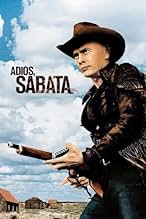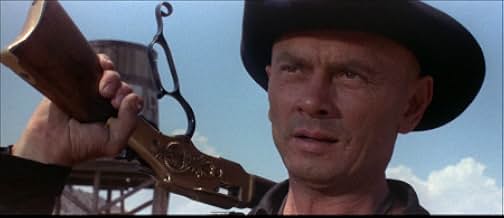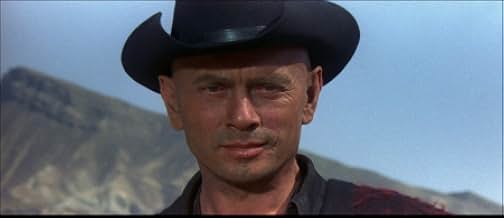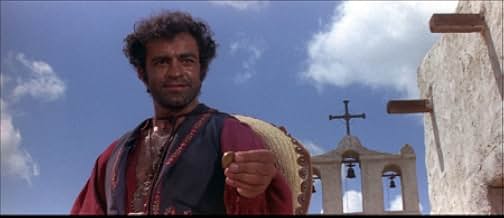NOTE IMDb
5,9/10
2,5 k
MA NOTE
Ajouter une intrigue dans votre langueSabata helps a band of Mexican revolutionaries steal a wagon-load of gold from the occupying Austrian forces of Emperor Maximilian I.Sabata helps a band of Mexican revolutionaries steal a wagon-load of gold from the occupying Austrian forces of Emperor Maximilian I.Sabata helps a band of Mexican revolutionaries steal a wagon-load of gold from the occupying Austrian forces of Emperor Maximilian I.
- Réalisation
- Scénario
- Casting principal
Ignazio Spalla
- Escudo
- (as Pedro Sanchez)
Gérard Herter
- Colonel Skimmel
- (as Gerard Herter)
Turam Quibo
- Gitano
- (as Joseph Persaud)
Nieves Navarro
- Kingsville Saloon Dancer
- (as Susan Scott)
Vittorio Caronia
- 1st Lt. Steiner
- (as Vitti Caronia)
Avis à la une
The manic westerns of Gianfranco Parolini are like surreal comic books with outrageous editing and angles, bizarre weaponry, confusing language, episodic plots where every scene has a punchline, and ridiculous costumes. His films have a sense of tongue in cheek fun that comes through clearly thirty years later. It appears that the circus was his model, unpretentious entertainment pure and simple. There is absolutely no serious intention in his movies. That is why he remains the guilty pleasure of a number of fans of spaghetti westerns and eurotrash films in general. Along with Sabata (1970), Adios, Sabata is one of his "best".
The score by Bruno Nicolai is excellent, though reminiscent of Morricone's scores for the first 2 Leone movies.
The movie was originally intended be about a character called Indio Black, but with the success of Sabata the names were changed.
The five best things about this film: 1)Yul Brynner's black outfit with leather trim, an open vest, and bell bottoms 2)Lines like (spoken by Brynner), "Now let's get moving. Every Austrian in the territory will be looking for us." 3)The devious Colonel Skimmel 4)Every Austrian wears a black suit, tie, and bowler hat, making them somewhat conspicuous 5)The cast of revolutionary characters each with a unique ability or weapon
Top spaghetti western list http://imdb.com/mymovies/list?l=21849907
Average SWs http://imdb.com/mymovies/list?l=21849889
For fanatics only (bottom of the barrel) http://imdb.com/mymovies/list?l=21849890
The score by Bruno Nicolai is excellent, though reminiscent of Morricone's scores for the first 2 Leone movies.
The movie was originally intended be about a character called Indio Black, but with the success of Sabata the names were changed.
The five best things about this film: 1)Yul Brynner's black outfit with leather trim, an open vest, and bell bottoms 2)Lines like (spoken by Brynner), "Now let's get moving. Every Austrian in the territory will be looking for us." 3)The devious Colonel Skimmel 4)Every Austrian wears a black suit, tie, and bowler hat, making them somewhat conspicuous 5)The cast of revolutionary characters each with a unique ability or weapon
Top spaghetti western list http://imdb.com/mymovies/list?l=21849907
Average SWs http://imdb.com/mymovies/list?l=21849889
For fanatics only (bottom of the barrel) http://imdb.com/mymovies/list?l=21849890
Long before the Terminator, Sabata (this time Yul Brynner in his only spaghetti western) uttered the infamous words, "I'll be back." This is the second of Gianfranco Parolini's Sabata trilogy, but it is not a sequel, as the characters and story are different. Like the first, it is also written by Renato Izzo, who went on to write the video nasty Night Train Murders after finishing the trilogy.
Brynner had the cool look that probably got him the Westworld gig a few years later.
Ignazio Spalla is back from the fist film, but with a different name (Escudo). Maybe he changed it to hide.
Sabata joins Escudo and revolutionaries trying to overthrow Austrian Archduke Maximillion, who ruled over Mexico as an imperial dictator; of course, Sabata was only after gold. Others were as well, so it was not a walk in the park.
It is fortunate that the Archduke had plenty of soldiers to sacrifice to the cause.
Well, Lee Van Cleef, Ignazio Spalla, and Aldo Canti will be back in the final Sabata film.
Brynner had the cool look that probably got him the Westworld gig a few years later.
Ignazio Spalla is back from the fist film, but with a different name (Escudo). Maybe he changed it to hide.
Sabata joins Escudo and revolutionaries trying to overthrow Austrian Archduke Maximillion, who ruled over Mexico as an imperial dictator; of course, Sabata was only after gold. Others were as well, so it was not a walk in the park.
It is fortunate that the Archduke had plenty of soldiers to sacrifice to the cause.
Well, Lee Van Cleef, Ignazio Spalla, and Aldo Canti will be back in the final Sabata film.
Ok so it was supposed to be called INDIO BLACK as well as it should have been.
After all, Yul Brynner played the character far differently than Lee Van Cleef did and this film really shouldn't be associated with the other two Sabata films. It's a different character look altogether with the Brynner version dressed in black buckskin and silver buckles while the Van Cleef version of Sabata settled more for the conservative Bret Maverick gambler look.
Also notably stars failed American singer Dean Reed who would later die under mysterious circumstances in East Germany during the 1980s.
The Bruno Nicolai score is excellent although derivative of other scores for the genre. If you like soundtracks for these types of films, then it's well worth picking up. I know I'll be on the lookout for it.
Lots of explosions and gunfire in this one as Brynner & Co. battle the Austrians under Maximillian (in Mexico circa 1867) and steal their gold. There's nothing boring about it and it's face-paced with a few tricks such as the model of the ship in Colonel Skimmel's study that shoots real live ammo everytime someone opens the drawer below it. I also like Brynner's sawed-off rifle with the clip that loads from the side. He keeps a cigar in the last chamber and lights it up after every gun battle. Very tongue-in-cheek.
I liked it. Too bad the widescreen version was cropped for television.
6 out of 10
After all, Yul Brynner played the character far differently than Lee Van Cleef did and this film really shouldn't be associated with the other two Sabata films. It's a different character look altogether with the Brynner version dressed in black buckskin and silver buckles while the Van Cleef version of Sabata settled more for the conservative Bret Maverick gambler look.
Also notably stars failed American singer Dean Reed who would later die under mysterious circumstances in East Germany during the 1980s.
The Bruno Nicolai score is excellent although derivative of other scores for the genre. If you like soundtracks for these types of films, then it's well worth picking up. I know I'll be on the lookout for it.
Lots of explosions and gunfire in this one as Brynner & Co. battle the Austrians under Maximillian (in Mexico circa 1867) and steal their gold. There's nothing boring about it and it's face-paced with a few tricks such as the model of the ship in Colonel Skimmel's study that shoots real live ammo everytime someone opens the drawer below it. I also like Brynner's sawed-off rifle with the clip that loads from the side. He keeps a cigar in the last chamber and lights it up after every gun battle. Very tongue-in-cheek.
I liked it. Too bad the widescreen version was cropped for television.
6 out of 10
This is not really a Sabata film, but often Italian westerns pretended to be sequels just to get unwitting customers to come to see the films*. For example, Franco Nero's "Django" was very successful so practically every Italian film producer brought out a Django film but with a different leading man--and a completely different plot! Here, cashing in on the Sabata craze (small as it was), a non-Sabata film starring Yul Brynner is suddenly a Sabata film thanks to dubbing! In fact, originally, Brynner's character was called 'Indigo Black'. I checked and there were seven Sabata films--only two which are REAL Sabata films with Lee Van Cleef. The rest, like "Adios Sabata" are just rip-offs. So is this a BAD rip-off or a decent and watchable rip-off? Read on to see...
The plot of this film is close to that of a real Sabata film in that although he looks mean and shoots people by the score, this incarnation finds him doing this in order to help the Mexican Civil War of 1867. Now that doesn't mean he won't take a percentage for himself as well! A percentage of what you may ask....GOLD. It seems an evil (but very stylish) Austrian colonel is shipping gold--gold which could be used by the revolutionaries to buy weapons. However, Sabata isn't alone in this quest--he's taking along a fat guy, two VERY strange acrobats and a pretty-boy named Ballentine--who you KNOW is up to no good.
As far as Italian westerns go, this theme is VERY common--though most of the time the hero is helping the anti-Diaz forces of the Mexican Civil War of the 1910s. This one is set much earlier and has to do with getting rid of the imposed leader, Maximillian. Regardless, this one is reasonably entertaining, full of insanely good shots and has a touch of humor. Worth seeing but not a particularly novel film...except when it comes to one of the acrobats. His skill is handling a very large ball bearing kind of like a hacky sack--which he then hurls with his foot at people with deadly accuracy! Ha...worth seeing just to see this guy in action. ball bearing guy
*The same spirit of intellectual dishonesty was also rampant in Asian films after the death of Bruce Lee. Many supposedly new and recently discovered Lee films flooded the market--starring folks such as Bruce Li or consisting of home movies of Lee or outtakes from his films interspersed with a double wearing sunglasses! These films were ALL horrible--whereas a few of the Italian knockoffs were actually watchable. Plus, at least the Italian films had cool music.
The plot of this film is close to that of a real Sabata film in that although he looks mean and shoots people by the score, this incarnation finds him doing this in order to help the Mexican Civil War of 1867. Now that doesn't mean he won't take a percentage for himself as well! A percentage of what you may ask....GOLD. It seems an evil (but very stylish) Austrian colonel is shipping gold--gold which could be used by the revolutionaries to buy weapons. However, Sabata isn't alone in this quest--he's taking along a fat guy, two VERY strange acrobats and a pretty-boy named Ballentine--who you KNOW is up to no good.
As far as Italian westerns go, this theme is VERY common--though most of the time the hero is helping the anti-Diaz forces of the Mexican Civil War of the 1910s. This one is set much earlier and has to do with getting rid of the imposed leader, Maximillian. Regardless, this one is reasonably entertaining, full of insanely good shots and has a touch of humor. Worth seeing but not a particularly novel film...except when it comes to one of the acrobats. His skill is handling a very large ball bearing kind of like a hacky sack--which he then hurls with his foot at people with deadly accuracy! Ha...worth seeing just to see this guy in action. ball bearing guy
*The same spirit of intellectual dishonesty was also rampant in Asian films after the death of Bruce Lee. Many supposedly new and recently discovered Lee films flooded the market--starring folks such as Bruce Li or consisting of home movies of Lee or outtakes from his films interspersed with a double wearing sunglasses! These films were ALL horrible--whereas a few of the Italian knockoffs were actually watchable. Plus, at least the Italian films had cool music.
In his one and only venture into the pasta western, Yul Brynner finds himself succeeding Lee Van Cleef as the mysterious gunfighter Sabata who gets himself involved in Mexican politics in trying to overthrow the Emperor Maximilian. There hasn't been a film yet where the Juaristas aren't the good guys, even in Juarez where Brian Aherne made a sympathetic if somewhat naive Maximilian. It's such a clear case of imperialism.
But Yul isn't a total good guy and he teams up with three partners to steal a shipment of gold from the occupiers and give it to the Juaristas ostensibly. Actually the four of them are only as good as they have to be. And they've got another along, an American played by the only American actor in Adios Sabata, Dean Reed, who has an agenda all his own who keeps a positively explosive diary.
As most of us know even those who get their history from films, the Emperor Maximilian was an Austrian, but who was put on the newly created Mexican throne by the French and sustained by the French army. But here we have Austrian occupiers including an Austrian commander who also has a private agenda. I'm betting the producers were thinking that German types make so much better villains than the French.
Sabata's distinguishing characteristic was a rife that he had a long holster for and drew like a revolver. This rife had a unique horizontal magazine from where the bullets came. But the last chamber always had a cigar which Yul would light up after a killing well done.
I'm not a fan of spaghetti westerns and don't usually give them good reviews. It's the American genre and should be done by Americans. This one is no exception. But I will say that Yul Brynner's cynical look throughout the film is quite priceless.
But Yul isn't a total good guy and he teams up with three partners to steal a shipment of gold from the occupiers and give it to the Juaristas ostensibly. Actually the four of them are only as good as they have to be. And they've got another along, an American played by the only American actor in Adios Sabata, Dean Reed, who has an agenda all his own who keeps a positively explosive diary.
As most of us know even those who get their history from films, the Emperor Maximilian was an Austrian, but who was put on the newly created Mexican throne by the French and sustained by the French army. But here we have Austrian occupiers including an Austrian commander who also has a private agenda. I'm betting the producers were thinking that German types make so much better villains than the French.
Sabata's distinguishing characteristic was a rife that he had a long holster for and drew like a revolver. This rife had a unique horizontal magazine from where the bullets came. But the last chamber always had a cigar which Yul would light up after a killing well done.
I'm not a fan of spaghetti westerns and don't usually give them good reviews. It's the American genre and should be done by Americans. This one is no exception. But I will say that Yul Brynner's cynical look throughout the film is quite priceless.
Le saviez-vous
- AnecdotesThis was not originally a Sabata film. The original Italian title translates as "Indio Black, you know what? You're a big son of a...", Indio Black being the character played by Yul Brynner, but the title and Brynner's character name were changed for the American release to cash in on Sabata (1969), the original Sabata film. Lee Van Cleef was asked to star in this film, but rejected the offer for some reason. He was then replaced by Brynner, whose character would only be called Sabata in the international English language version, and Indio Black in the Italian version. However, lip reading viewers have noticed that the actors who mouth their lines in English, seem to say "Sabata", not "Indio", so the re-baptism took place while the film was still being shot.
- GaffesWhen Sabata invades Colonel Skimmel's quarters, he sees the reflection of a person hiding behind the door. The person in the reflection is not Hertz.
- ConnexionsEdited into Spaghetti Western Trailer Show (2007)
Meilleurs choix
Connectez-vous pour évaluer et suivre la liste de favoris afin de recevoir des recommandations personnalisées
- How long is Adiós, Sabata?Alimenté par Alexa
Détails
Box-office
- Montant brut aux États-Unis et au Canada
- 546 926 $US
- Durée1 heure 44 minutes
- Rapport de forme
- 2.35 : 1
Contribuer à cette page
Suggérer une modification ou ajouter du contenu manquant

Lacune principale
By what name was Adios Sabata (1970) officially released in India in English?
Répondre




























